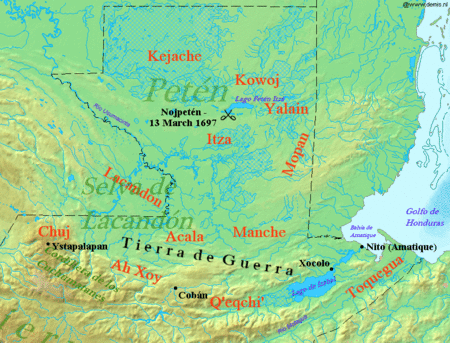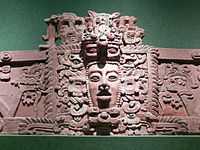Kejache

The Kejache (/keˈχätʃe/) (sometimes spelt Kehache, Quejache, Kehach or Kejach) were a Maya people in the southern Yucatán Peninsula at the time of Spanish contact in the 17th century.[1] The Kejache territory was located in the Petén Basin in a region that takes in parts of both Guatemala and Mexico. Linguistic evidence indicates that the Kejache shared a common origin with the neighbouring Itzas to their southeast and the Kejache may have occupied the general region since the Classic period (c. AD 250-900). The Kejache were initially contacted by conquistador Hernán Cortés in 1525, they were later in prolonged contact with the Spanish as the latter opened a route southwards towards Lake Petén Itzá.
Territory
The Kejache occupied a region that is now crossed by the border between Guatemala and the Mexican state of Campeche,[2] in an area measuring approximately 40 by 100 kilometres (25 by 62 mi) extending from lakes Silvituk and Moku in Mexico southwards towards Uaxactun in Guatemala.[3] The Kejache held a province that lay between the Itza kingdom centred on the city of Nojpetén and what, after the initial stages of the Spanish conquest, became the Spanish-held Yucatán to the north.[1] The Kejache were bordered immediately to the north by the territory of the Acalan, a Chontal Maya people.[4] The precise geopolitical extent of the Kejache is poorly understood,[5] and no archaeological surveys of the Kejache territory have taken place.[6] The Kejache territory consisted of a region of low hills with wide valleys that form swamplands during the rainy season, the region is also characterised by a number of small lakes, such as Lake Moku, Lake Silvituk and Chan Laguna.[2]
Culture
The Kejache, as described by the Spanish, were poorer than neighbouring Maya peoples, using wood and thatch as building materials and lacking material resources.[7] Kejache weapons consisted of short spears and bows and arrows; apparently they did not use shields, unlike their neighbours. The Kejache cultivated maize, black beans, squash and turkeys. The Kejache traded with the Acalan Maya to their northwest, exchanging cotton clothing for salt.[8]
By the mid-17th century the Kejache were important intermediaries between the Itza and Yucatán. The Putun Acalan subgroup of the Kejache had previously traded directly with the Itza but had been relocated by the Spanish. The remaining Kejache, decimated by disease and subject to the intense attentions of Spanish missionaries, were no longer able to supply the Itza directly and became middlemen instead.[9]
Language and etymology
Kejache was the name by which they identified themselves to others.[10] The Kejache spoke the Yucatec Maya language,[4] and the name kejache is derived from the Yucatec words kej meaning "deer" and ach, which was a suffix that may have indicated the abundance of the animals.[11] The Kejache territory was referred to as Mazatlan in the Nahuatl language of the Aztecs;[12] the Spanish conquistador Bernal Díaz del Castillo interpreted the "land of the Mazatecas" as the "town or lands of deer".[11] The Kejache shared many surnames with the neighbouring Itzas and, despite the later hostility between the two peoples, it is likely that they had a common origin.[6]
History
 |
| Maya civilization |
|---|
| History |
| Preclassic Maya |
| Classic Maya collapse |
| Spanish conquest of the Maya |
Although the Kejache seem to have had a common origin with the Itza, possibly as far back as the Late Classic period (c. AD 600-900) the approximate date of their division into separate peoples is unknown. The Kejache separation may have occurred due to either continued Itza migration to Petén during the Postclassic period (c. 900-1697) or because internal warfare caused them to divide. It is possible that the Kejache had occupied their territory since the Classic period and they may have been descendants of the inhabitants of the prominent Maya cities in the region, such as Calakmul and the cities of the Río Bec zone.[4]
The Kejache are likely to have occupied the Petén region of what is now northern Guatemala for a considerable time before being displaced by Itza expansion into the area north and northwest of the Itza kingdom. The Kejache province was frequently at war with the Itza and the two territories were separated by a deserted no-man's land. The Kejache are believed to have lacked a centralised political structure,[6] although their capital was said to be Mazatlan (as referred to in Nahuatl by Aztec merchants).[10] Ten Kejache towns are mentioned in Spanish colonial documents,[8] including Tiac and Yaxuncabil, mentioned by Hernán Cortés.[13]
Spanish conquest
Spanish conquistador Hernán Cortés passed through Kejache territory in 1525 en route to Honduras and reported that the Kejache towns were situated in easily defensible locations and were often fortified.[6] One of these was built on a rocky outcrop near a lake and a river that fed into it. The town was fortified with a wooden palisade and was surrounded by a moat. Cortés reported that the town of Tiac was even larger and was fortified with walls, watchtowers and earthworks; the town itself was divided into three individually fortified districts. Tiac was said to have been at war with the unnamed smaller town.[14] The Kejache claimed that their towns were fortified against the attacks of their aggressive Itza neighbours.[4] In 1531 Alonso Dávila crossed the north of Kejache territory in search of an adequate base of operations for conquest.[15]
The Kejache had a number of well-fortified towns built along the principal trade route from Campeche to Lake Petén Itzá.[16] The Spanish built a road through the Kejache territory from Campeche on the west coast of the Yucatán Peninsula and the Spanish established missions at the Kejache towns of Ichbalche and Tzuktok.[6] By the last decade of the 17th century, the Spanish also had a priest at Chuntuki, also on the new road (or camino real - "royal road").[17]
After the fall of the Itza to the Spanish invaders in 1697, the surviving Kejache fled with Itza and Kowoj refugees into the Lacandon forest, where they became the ancestors of the modern Lacandon people.[18]
Notes
- ↑ 1.0 1.1 Jones 2000, p. 353.
- ↑ 2.0 2.1 Chávez Gómez 2006, p. 58.
- ↑ Villa Rojas 1985, p. 447.
- ↑ 4.0 4.1 4.2 4.3 Rice and Rice 2005, p. 152.
- ↑ Rice 2009, p. 17.
- ↑ 6.0 6.1 6.2 6.3 6.4 Rice and Rice 2009, p. 12.
- ↑ Villa Rojas 1985, p. 455. Chavez Gomez 2006, p. 62.
- ↑ 8.0 8.1 Villa Rojas 1985, p. 455.
- ↑ Schwartz 1990, pp. 34–35.
- ↑ 10.0 10.1 Chávez Gómez 2006, p. 60.
- ↑ 11.0 11.1 Jones 1998, p. 435n13.
- ↑ Jones 1998, p. 31.
- ↑ Rice and Rice 2009, p. 12. Villa Rojas 1985, p. 455.
- ↑ Rice et al 2009, p. 127.
- ↑ Villa Rojas 1985, p. 450.
- ↑ Rice 2009, p. 19.
- ↑ Rice et al 2009, p. 138.
- ↑ Hofling 2009, p. 78.
References
- Chávez Gómez, José Manuel A. (2006). "La Recreación del Antiguo Espacio Político. Un Cuchcabal Kejache y el Na'al Kejach Chan en el siglo XVII". Nuevas Perspectivas Sobre la Geografía Política de los Mayas. Mexico City, Mexico: Universidad Nacional Autónoma de México, Universidad Autónoma de Campeche and the Foundation for the Advancement of Mesoamerican Studies, Inc (FAMSI). pp. 57–80. ISBN 970-32-3208-6. OCLC 69676215. Retrieved 2013-01-25. Invalid
|name-list-format=scap(help) (Spanish) - Hofling, Charles Andrew (2009). "The Linguistic Context of the Kowoj". In Prudence M. Rice and Don S. Rice (eds.). The Kowoj: identity, migration, and geopolitics in late postclassic Petén, Guatemala. Boulder, Colorado, US: University Press of Colorado. pp. 71–79. ISBN 978-0-87081-930-8. OCLC 225875268. Invalid
|name-list-format=scap(help) - Jones, Grant D. (1998). The Conquest of the Last Maya Kingdom. Stanford, California, USA: Stanford University Press. ISBN 9780804735223. OCLC 9780804735223. Invalid
|name-list-format=scap(help) - Jones, Grant D. (2000). "The Lowland Maya, from the Conquest to the Present". In Richard E.W. Adams and Murdo J. Macleod (eds.). The Cambridge History of the Native Peoples of the Americas, Vol. II: Mesoamerica, part 2. Cambridge, UK: Cambridge University Press. pp. 346–391. ISBN 0-521-65204-9. OCLC 33359444. Invalid
|name-list-format=scap(help) - Rice, Prudence M. (2009). "Who were the Kowoj?". In Prudence M. Rice and Don S. Rice (eds.). The Kowoj: identity, migration, and geopolitics in late postclassic Petén, Guatemala. Boulder, Colorado, US: University Press of Colorado. pp. 17–19. ISBN 978-0-87081-930-8. OCLC 225875268. Invalid
|name-list-format=scap(help) - Rice, Prudence M.; Don S. Rice (2005). "Sixteenth- and Seventeenth-Century Maya Political Geography". In Susan Kepecs and Rani T. Alexander. The Postclassic to Spanish-Era Transition in Mesoamerica: Archaeological Perspectives. Albuquerque, New Mexico, USA: University of New Mexico Press. ISBN 9780826337399. OCLC 60550555. Invalid
|name-list-format=scap(help) - Rice, Prudence M.; Don S. Rice (2009). "Introduction to the Kowoj and their Petén Neighbors". In Prudence M. Rice and Don S. Rice (eds.). The Kowoj: identity, migration, and geopolitics in late postclassic Petén, Guatemala. Boulder, Colorado, US: University Press of Colorado. pp. 3–15. ISBN 978-0-87081-930-8. OCLC 225875268. Invalid
|name-list-format=scap(help) - Rice, Prudence M.; Don S. Rice; Timothy W. Pugh; Rómulo Sánchez Polo (2009). "Defensive architecture and the context of warfare at Zacpetén". In Prudence M. Rice and Don S. Rice (eds.). The Kowoj: identity, migration, and geopolitics in late postclassic Petén, Guatemala. Boulder, Colorado, US: University Press of Colorado. pp. 123–140. ISBN 978-0-87081-930-8. OCLC 225875268. Invalid
|name-list-format=scap(help) - Schwartz, Norman B. (1990). Forest Society: A Social History of Petén, Guatemala. Ethnohistory. Philadelphia, Pennsylvania, USA: University of Pennsylvania Press. ISBN 9780812213164. OCLC 21974298. Invalid
|name-list-format=scap(help) - Villa Rojas, Alfonso (1985). "Los Quejaches: Tribu Olvidada del Antiguo Yucatán". Estudios Etnológicos: Los Mayas. Serie Antropológica 38. Mexico City, Mexico: Universidad Nacional Autónoma de México. pp. 447–462. ISBN 9789688375655. OCLC 15544002. Retrieved 2013-01-29. Invalid
|name-list-format=scap(help) (Spanish)
Further reading
- Houwald, Götz von (1984). "Mapa y Descripción de la Montaña del Petén e Ytzá. Interpretación de un documento de los años un poco después de la conquista de Tayasal" (PDF). Indiana (Berlin, Germany: Ibero-Amerikanisches Institut) (9). ISSN 0341-8642. OCLC 2452883. Retrieved 2012-12-03. Invalid
|name-list-format=scap(help) (Spanish) - Thompson, Sir Eric (1977). "A Proposal for Constituting a Maya Subgroup, Cultural and Linguistic, in the Petén and Adjacent Regions". In Grant D. Jones. Anthropology and History in Yucatán (Kindle). The Texas Pan American Series. Austin, Texas, US: University of Texas Press. 476. doi:10.7560/703148. ISBN 978-0-292-76678-5. OCLC 2202479. Invalid
|name-list-format=scap(help)